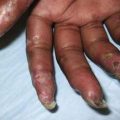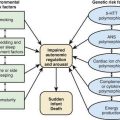Chapter 459 Hemolytic Anemias Secondary to Other Extracellular Factors
Fragmentation Hemolysis (See Table 451-1)
Red blood cell (RBC) destruction may occur in hemolytic anemias because of mechanical injury as the cells traverse a damaged vascular bed. Damage may be microvascular when RBCs are sheared by fibrin in the capillaries during intravascular coagulation or when renovascular disease accompanies the hemolytic-uremic syndrome (Chapter 512) or thrombotic thrombocytopenic purpura (Chapter 478.5). Larger vessels may be involved in Kasabach-Merritt syndrome (giant hemangioma and thrombocytopenia; Chapter 499) or when a replacement heart valve is poorly epithelialized. The blood film shows many “schistocytes,” or fragmented cells, as well as polychromatophilia, reflecting the reticulocytosis (see Fig. 452-4F). Secondary iron deficiency may complicate the intravascular hemolysis because of urinary hemoglobin and hemosiderin iron loss (see Fig. 451-2). Treatment should be directed toward the underlying condition, and the prognosis depends on the effectiveness of this treatment. The benefit of transfusion is transient because the transfused cells are destroyed as quickly as those produced by the patient.
Toxins and Venoms
Bacterial sepsis due to Haemophilus influenzae, staphylococci, and streptococci may be complicated by accompanying hemolysis. Particularly severe hemolytic anemia has been observed in clostridial infections and results from a hemolytic clostridial toxin. Large numbers of spherocytes may be seen on the blood film. Spherocytic hemolysis also may be noted after bites by various snakes, including cobras, vipers, and rattlesnakes, which have phospholipases in their venom. Large numbers of bites by insects, such as bees, wasps, and yellow jackets, also may cause spherocytic hemolysis by a similar mechanism (Chapter 706).
Grudeva-Popova JG, Spasova MI, Chepileva KG, et al. Acute hemolytic anemia as an initial clinical manifestation of Wilson’s disease. Folia Med (Plovdiv). 2000;42:42-46.
Sakuri J, Nagahama M, Oda M. Clostridium perfringens alpha-toxin: characterization and mode of action. J Biochem (Tokyo). 2004;136:569-574.







